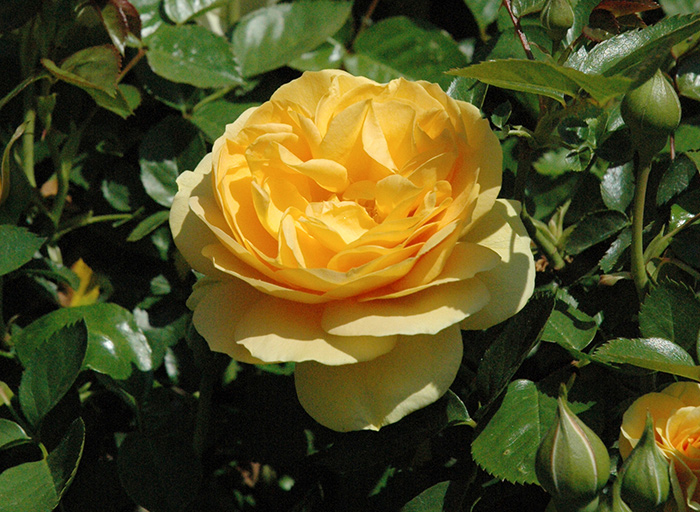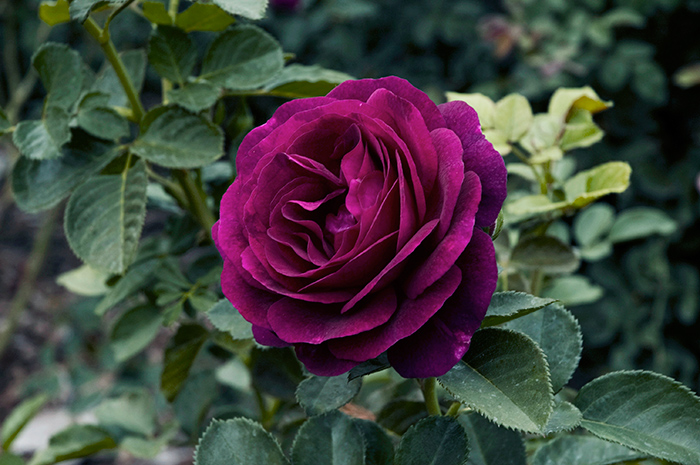The Huntington’s blog takes you behind the scenes for a scholarly view of the collections.
A Nose for the Rose
Posted on Tue., July 28, 2015 by
The rose looks fair, but fairer we it deem,
For that sweet odour, which doth in it live . . .
So wrote Shakespeare four centuries ago, and many people today would agree that while the beauty of a rose is exceptional, what truly inspires us is its scent.
The Huntington’s historic Rose Garden is home to 1,400 rose cultivars, with two large beds dedicated entirely to the collection’s most fragrant roses. Cultivars like 'Twilight Zone' and 'Julia Child' have a spicy scent, while fruitier fragrances like those of 'Just Joey' and 'George Burns' also hang in the air.
Not that producing fragrant roses is a walk in the park for plant hybridizers.
As luck would have it, lack of fragrance is a dominant trait, showing up far more frequently than the recessive trait of fragrance, says Tom Carruth—an award-winning hybridizer of roses and the E.L. and Ruth B. Shannon Curator of the Rose Collections at The Huntington.
“For a rose to have a strong scent, it must inherit the fragrance gene from both of its parents,” says Carruth. In addition, perfume is genetically linked in roses to color instability, shorter vase life, and disease susceptibility, further challenging rose breeders.
That perhaps explains why some people mistakenly got the impression that roses had lost their scent. Not so, says Carruth. Most breeders of the 1950s, 60s, and 70s were striving for lasting pure colors to the detriment of fragrance. Yet a few diligent hybridizers of that time recognized the marketability of new and potently fragrant cultivars, laying the groundwork for modern garden roses of today. Gardeners have an abundant choice of beautiful and perfumed roses.
The florist trade, on the other hand, still struggles to produce plants combining beauty and fragrance. Today, florist roses are imported from distant countries—such as Ecuador, Israel, and Kenya. For these roses, long-life and lasting color are paramount.
“Greenhouse roses are bred for stable color, stem length, and shipability,” says Carruth. “Those characteristics have generally come at the expense of fragrance.”

Developed by Carruth in 2004, ‘Julia Child’ is prized for its spicy fragrance and constant yellow blooms. Celebrity chef Julia Child chose the cultivar to bear her name. Photo by Lisa Blackburn.
Help may be on the way thanks to some recent research. Scientists at the French National Institute for Agricultural Research announced earlier this month that they have discovered the gene that causes the rose’s scent. The identification of the gene may enable both garden and florist rose hybridizers to breed fragrant roses more consistently.
In the meantime, The Huntington’s garden roses smell wonderful. Some of the garden’s most aromatic cultivars include ‘Twilight Zone’, redolent of clove and lemon; ‘Tamora’, with its strong scent of myrrh; and ‘Julia Child’, whose perfume recalls sweet licorice and spice.
“Give the newer garden roses a try,” says Carruth, “It’s time to stop and smell them again.”
Related content on Verso:
Tough Love for Roses (May 5, 2015)
Sara Schacht is an intern in the office of communications and marketing at The Huntington.

